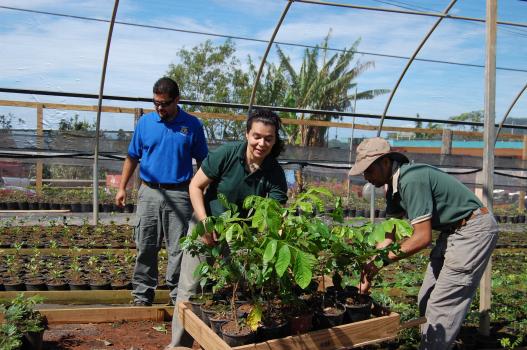September 2023 Edition | Volume 77, Issue 9
Published since 1946
Shade-Coffee as a Beacon for Sustainability: Implementing Conservation without Conflict in Puerto Rico
Coffee, adored by many around the globe, flourishes in over 80 tropical countries. Beyond its role as a morning ritual, its vast annual sales of more than $165 billion position it as a cornerstone of global trade. As this cherished commodity ripples through the world's economies, its significance is especially pronounced in developing nations, where, astoundingly, coffee can constitute over 80% of export revenues. New efforts to embrace shade-grown coffee illustrate how sustainable agriculture practices can be implemented using the vision of Conservation without Conflict.

Nidia Trejo, Envirosurvey and Ramon Rivera, PRDNER loading a cart full of shade producing trees. In the background, Omar Monsegur, USFWS. A total of 6,600 seedlings were planted within 291 acres of coffee, oranges and banana plantations in the Yauco and Maricao Mountains of Puerto Rico.
Lilibeth Serrano, USFWS
Let's embark on a journey through the realms of coffee cultivation. Two predominant practices stand out: shade-grown and sun-grown. Shade-grown coffee flourishes beneath a protective umbrella of towering trees. These trees, often indigenous to the area, play a multifaceted role. They provide vital habitats for wildlife, shield delicate soils, and conserve crucial water sources. Wander through a shade coffee estate, and you'll observe an environment where nature thrives, offering a natural deterrent to pests and playing a pivotal role in natural reserve management.
In contrast, sun-grown coffee farms prioritize yield. Eliminating the protective canopy, they expose coffee plants to the unrelenting sun. While this might boost production for a few years, it falls short of the biodiversity and environmental benefits of its shaded counterpart, lacking support for native flora and fauna and requiring a heavy influx of fertilizers and pesticides.
The United States, renowned as the world's top coffee consumer, also dons the lesser-known hat of a producer. Its tropical areas, primarily Hawaii and Puerto Rico, host its coffee estates. Hawaii leans toward sun-grown coffee, but Puerto Rico holds onto the time-honored tradition of shade-grown farming. But the value of these shaded farms extends beyond their environmental role. They stand as bastions of diversified farming, showcasing a harmonious coexistence of multiple crops. In fact, over 50 different crops have been identified in Puerto Rican shade coffee plantations.
Ever since coffee's introduction to Puerto Rico in the mid-1700s, it has been the foundation of a diversified agricultural fabric, producing a rich array of food and wood, vital to local communities. In Puerto Rico's verdant farms, a wide variety of crops grow alongside coffee—from bananas and avocados to mangoes—creating an economic safety net for farmers amidst the unpredictable waves of market prices. Diversity is, undoubtedly, the best defense against the uncertainties of farming.
These shade coffee farms have been stalwarts of Puerto Rican biodiversity for nearly three centuries, ensuring both ecological balance and economic sustenance. They've sheltered countless species from the brink of extinction (like the Puerto Rican Parrot), while also nourishing numerous families. Today, their importance is undiminished, continuing to play a pivotal role in both conservation and economic sustainability.
Recognizing their immense value, many coffee growers are reverting from monocultures to this traditional shade-grown model. Collaborating with entities like the U.S. Fish and Wildlife Service, the Natural Resources Conservation Service, and esteemed NGOs such as EnviroSurvey Inc. and Protectores de Cuencas, the Puerto Rican Center for Landscape Conservation, and North Carolina State University, coffee producers are leading the charge toward a more sustainable future.
Shade coffee farming, a practice with deep historical roots, is re-emerging at the forefront in today's world of mounting environmental and economic challenges. It stands as a shining example of sustainable agriculture, illuminating a path forward that seamlessly marries conservation with economic sustainability. In essence, shade coffee farming underscores the promise of "Conservation without Conflict," delineating a blueprint to satisfy both ecological and economic needs.
Visit the NC State University website for more information on recent efforts.
References:
Brash, A. R. 1987. The history of avian extinction and forest conversion in Puerto Rico. Biological Conservation 39: 97-111.
Jha Shalene, C.M. Bacon, S.M. Philpott, V. E. Mendez, P. Laderach, and R.A. Rice. 2014. Shade Coffee: Update on a Disappearing Refuge for Biodiversity. BioScience. https://academic.oup.com/bioscience/article/64/5/416/2754235
Prado, S.G., J.A. Collazo and R.E. Irwin. 2018. Resurgence of specialized shade coffee cultivation: Effects on pollination services and quality of coffee production. (https://www.usgs.gov/publications/resurgence-specialized-shade-coffee-cultivation-effects-pollination-services-and).